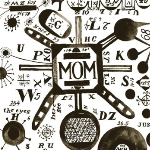
Mouse On Mars Parastrophics
(Monkeytown)
That Mouse On Mars have been making and releasing electronic music of the most far-reaching, playful and joyous kind for the best part of 18 years, is a fact that is quite honestly beggars belief. OK, so Jan St Werner and Andi Toma have been ‘on a break’ since 2006, concentrating on solo projects and collaborations rather than the MoM brand, but their overall career (if you want to call it that) arc is remarkably consistent. Early albums such as Vulvaland (1994) and Iahora Tahiti (1995) mixed a dance music approach with ambient styling, but even at this early stage on the latter you can detect the wild eclecticism of later albums. Iahora Tahiti is probably their best early work, taking on influences from a wide variety of contemporary dance styles, especially the nascent drum’n’bass movement, but using them to underpin a keen pop sensibility and a sense of humour rare in the usually spartan world of electronica. This playfulness continued throughout the 1990s leading ultimately to arguably their greatest album – the extraordinary Niun Niggung in 2000. This was not only a distillation but a concentration of all aspects of their sound, but seemed also to push the envelope of electronic music almost to its limit. For some, the pell-mell aggregation of sound – the blips, beeps, burps and beats – was too much. But for those willing to surrender to the madness, this was utter bliss. The complexity of tracks such as Distroia or Diskdusk was astonishing; as if the duo had thrown everything they had at the wall and waited to see what stuck. The following year’s Idiology was less arresting, but continued a trend towards more organic instrumentation, with occasional (live) drummer Dodo N’Kishi adding vocals on some tracks. 2006’s Varchaz featured a more abrasive electro sound, and was also their last as MoM until now.
Parastrophics sees the duo returning in part to their house and techno roots, but thankfully the signature schizoid humour and restlessness remains. The album displays a structural approach to making this kind of music that could descend into virtuosity for its own sake, but it avoids this by never taking itself seriously for a second. Diversity is the key here, and it’s interesting to note that other artists operating at the moment such as Rustie or Zomby are taking a similar free-for-all approach to dance music history, plundering the last 20 years of back-catalogue for influences and ideas, which they then twist into shapes of their own devising. Of course MoM have been doing just this for the last 20 years anyway, so as they say, there’s nothing new… The success of this album however lies in the way that each track sounds like a piece of music that has been conceived and composed as a song with its own internal sense of structure and logic – as crazy as that logic may be. It’s this that sets them apart from many of their peers, especially those who see the technology as the star, rather than the music. Songs such as Polaroyced or They Know Your Name contain a humanity that stems from the aforementioned humour injected into the music. Part of this stems from the plethora of noise-bursts, parps, farts and squelches that randomly pepper the songs, and partly from the exuberant bounciness with which the songs are propelled. Where MoM succeed is in making this eclecticism in entirely their own voice, sounding like no-one else but themselves. Parastrophics is their best album since Niun Niggung. The very fact of its being is cause for celebration, as is the continued existence of Mouse On Mars themselves. In an age of musical ephemerality and impermanence (especially in the electronica/dance arena) it’s good to know that sometimes innovation and inspiration can go hand in hand with experience.
14 March, 2012 - 22:33 — David John Wood